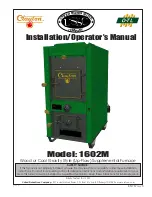
18-CD35D1-1 13
INSTALLER’S GUIDE
or “Exhibit J” of ANSI Z21.47 • CAN/ CGA-2.3 Standards.
The following are general steps to be used to correct or resize
a remaining vent system when a furnace which may not be
common vented is removed from the system:
a. Determine the BTU per hour input of all remaining
appliances attached to the venting system.
b. Determine the diameter, rise, and lateral of the existing
venting system, as well as quantity and type of bends.
c. Use the appropriate tables in the latest edition of
the National Fuel Gas Code (ANSI Z223.1 • CAN/
CGA B149.1 Installation Codes or “Exhibit J” of
ANSI Z21.47 • CAN/ CGA-2.3 Standards. “Exhibit
J” includes examples and drawings of typical venting
systems.
VENTING MATERIAL
PVC VENT FITTING MATERIAL
These fittings are available from your Gas Furnace Distributors.
Straight Pipe Sections, Couplings, 45° Elbows, 60° Elbows, 90°
Elbows, Vent or Sanitary Tee, or other necessary fittings may be
2", 2½", 3", or 4" diameter. The allowable materials are shown
in Table 10.
VENT FITTING MATERIAL – PLASTIC
Gas and liquid tight single wall vent fittings, designed for
resistance to corrosive flue condensate, MUST be used
throughout.
Listed in Table 10 are 2", 2½", 3", and 4" size fittings that meet
these requirements. The materials listed are various grades of
PVC and ABS plastic.
PIPE JOINTS: All joints must be fastened and sealed to prevent
escape of combustion products into the building.
NOTE: It is recommended that the first joints
from the furnace be connected and sealed with
high temperature RTV. This will enable the pipes
to be removed later without cutting.
Be sure to properly support these joints.
BONDING OF PVC
Commercially available solvent cement must be used to join the
pipe and fittings. Follow instructions on the container carefully.
Procedure for Cementing Joints:
1. Cut pipe square, remove ragged edges and burrs. Chamfer
end of pipe, then clean fitting socket and pipe joint area
of all dirt, grease, moisture or chips.
2. After checking pipe and socket for proper fit, wipe socket
and pipe with cleaner-primer. Apply a liberal coat of
primer to inside surface of socket and outside of pipe.
DO NOT ALLOW PRIMER TO DRY BEFORE APPLYING
CEMENT.
3. Apply a thin coat of cement evenly in the socket. Quickly
apply a heavy coat of cement to the pipe end and insert
pipe into fitting with a slight twisting movement until it
bottoms out.
4. Hold the pipe in the fitting for 30 seconds to prevent
tapered socket from pushing the pipe out of the fitting.
5. Wipe all excess cement from the joint with a rag. Allow
15 minutes before handling. Cure time varies according
to fit, temperature and humidity.
NOTE:
Follow venting instructions carefully when
using PVC cement.
IMPORTANT:
All joints must be water tight. Flue condensate
is somewhat acidic, and leaks can cause
equipment damage.
Connection of the pipe and collar of the combustion air inlet
should just be a friction fit. It is recommended that the inlet air
joint be sealed with RTV type sealant to allow the joint to be
separated for possible future service. The inlet and vent pipes
must be properly supported throughout the entire length.
▲
WARNING
!
CARBON MONOXIDE POISONING HAZARD
Do not replace any of the factory supplied venting
components with field fabricated parts. Failure to
follow this safety warning exactly could result in
damaged vents, damaged components, carbon
monoxide poisoning, or death.
Connection of the
vent pipe
to the vent collar should also be
accomplished using RTV type sealant. This type sealant provides
a connection which remains flexible and can be separated in the
future if service needs require the removal of the vent pipe for
service or clearance. See Figure 24.
Seal
VENT PIPE
with RTV sealant
Seal
INLET AIR PIPE
with RTV sealant
Front of Furnace
VENT AND INLET AIR CONNECTIONS
f














































